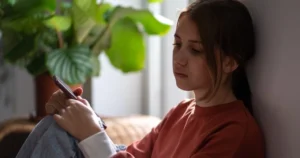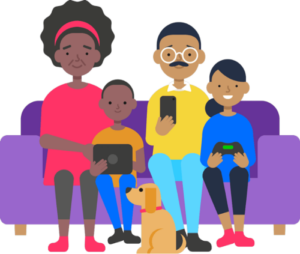Doomscrolling is when a person gets caught in a continuous cycle of reading negative news online. This can negatively impact both mental and physical health.
Learn how to spot if your child is doomscrolling, and what you can do to protect them.
Summary
- Doomscrolling is when a person compulsively scrolls through negative content.
- Social media algorithms, negativity bias and FOMO all encourage doomscrolling.
- Doomscrolling can increase mental health issues and negatively impact sleep.
- Signs of the behaviour can include stress, anxiety and low mood.
- Setting app time limits and curating social feeds can help prevent doomscrolling.
- You can explore more resources to support children’s wellbeing.
What is doomscrolling?
Doomscrolling (or doom scrolling) is when a person scrolls through social media and other media feeds for long periods. Generally, doomscrolling refers specifically to feeds which contain distressing or negative information.
The term’s usage grew in popularity during the Covid-19 pandemic. It came from people spending long periods scrolling through scary news regarding the pandemic. It now refers to compulsively reading about wars, crimes and disasters, falling into a rabbit hole of negative content.
Despite a lot of this content focusing on negative news, causing upset or anger, users still scroll through it. This can often lead to echo chambers, which can spread hate online.
Why do people doomscroll?
One reason people engage in doomscrolling behaviours is because of persuasive design and algorithms used by social media sites. Many social media feeds, for example, suggest new content based on what users interact with. Additionally, most feeds are endless, which means users can lose track of time and scroll without interruption.
Other reasons for doomscrolling might include:
- Control: Young people might feel more ‘in control’ of their own lives if they keep on top of negative events around the world.
- Curiosity: Some people have a morbid curiosity about negative news stories. This is similar to people’s interest in true crime podcasts or TV shows.
- FOMO: A fear of missing out (FOMO) on things that their peers are aware of can cause children to doomscroll. They might feel left out of conversations about scary news stories with friends if they don’t stay informed.
What are the potential impacts?
Doomscrolling can negatively impact children in a number of ways, both mentally and physically.
Increase in stress and anxiety
Viewing negative news can harm a young person’s mental health massively by reinforcing negative thoughts and feelings. When a child constantly sees the worst aspects of society, they might feel anxious or depressed about society. For some children, these feelings can develop into long-term mental health conditions. They might also worry that these things can happen to them in future.
Decreased empathy
Reading so much bad news can also desensitise children to violence and tragedies. This can lead to decreased empathy for others, as they are numb to bad news . Becoming desensitised can also make it difficult for child to recognise harm. As such, they might not know when to block or report harmful content because they don’t have a clear understanding of what ‘harmful’ looks like.
Lack of sleep
Doomscrolling is an addictive habit and can lead to an increase in screen time. As a result, it can impact children’s sleep.
Research also shows that the blue light from screens can make it harder to fall asleep, leading to increased tiredness during the day. This lack of sleep can lead to further mental and physical issues, including trouble focusing, increased blood pressure and depression.
Physical, mental and emotional impacts
Doomscrolling can increase the passive time your child spends on devices. Too much passive screen time can negatively impact communication, social and critical thinking skills. Additionally, time on devices is often sedentary, meaning children tend to sit still. This can impact their physical health, leading to weight gain or linked aches and pains.
Physical problems can also develop because of increased stress from doomscrolling. High levels of stress and anxiety can make the body tense. This can cause headaches and tiredness, among other stress-related physical problems.
Missing out on hobbies
If your child spend more time doomscrolling, it may leave them less interested in their hobbies. This can limit their personal growth and development.
Instead of passive scrolling, they should use their screens to learn, socialise and grow. Learn about screen time balance here.
Signs to look out for
Identifying doomscrolling in your child isn’t always easy or obvious, but there are signs you can look out for. Watch out for:
- increased anxiety and agitation when using their device;
- increased screen time because of addictive nature of doomscrolling;
- low mood or signs of depression.
Another sign that your child is doomscrolling is if they mention issues that are not suitable for their age. Their knowledge of these issues could suggest they are consuming a lot of negative content, possibly through doomscrolling.
Tips to manage doomscrolling
Doomscrolling can limit children’s ability to use their devices mindfully. They might not recognise when passive scrolling impacts their wellbeing. As such, it becomes easier to continue with doomscrolling behaviours.
No real benefits exist, so it is important to help children stop doomscrolling. The following tips can help:
Set app time limits
To stop your child from doomscrolling, consider setting a time limit to how much they can use certain apps each day. Most major social media platforms, video games and consoles allow you to set daily time limits. Some even offer options to set bedtime schedules. You can learn how to set these limits in our parental controls guides.
Unfollow negative accounts
Help your child unfollow or mute any social media accounts or channels that post high amounts of negative news. This will prevent content that might trigger doomscrolling.
Balance screen time
Consider setting boundaries around device use at home. For example, they must turn devices off an hour before bed. Or, they must charge devices in the kitchen overnight.
Remember that if you set these boundaries, everyone in your family (including you) must follow the rules. This will help your child get on board rather than seeing the rules as unfair. Use our Digital Family Agreement template to help your family agree on these rules.
Find new sources for news
Staying informed about what is going on in the world is valuable knowledge for children to have. So, consider giving your child newspapers, or finding a news source with more curated stories.
News sources designed for children also exist, including BBC Newsround and First News. These resources can help your child learn about current affairs without getting stuck in an algorithm that encourages doomscrolling.
Turn off notifications
You can choose to turn off notifications from social media platforms like TikTok and Instagram. This will prevent them from tempting your child to open the apps and begin a doomscrolling session.







